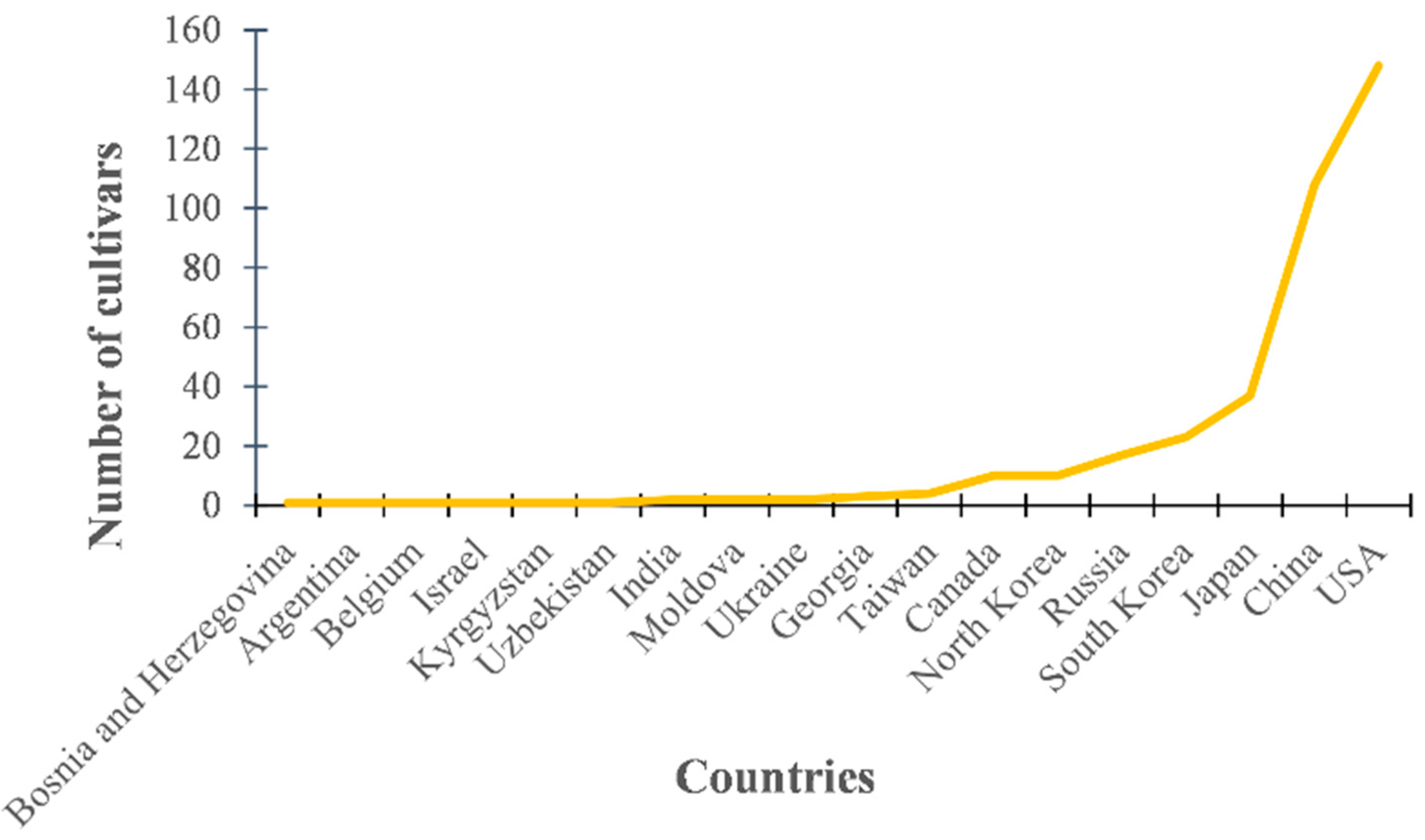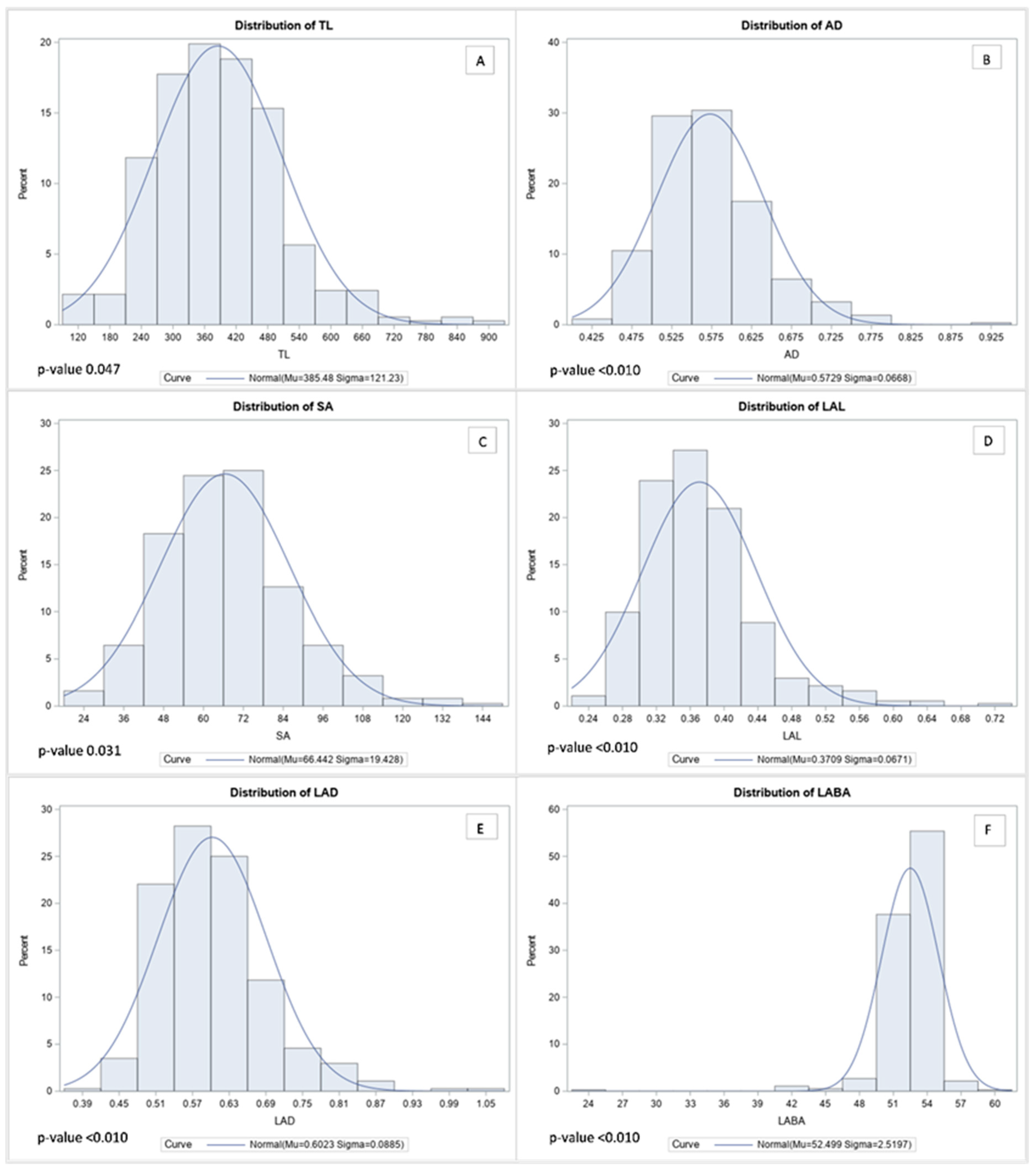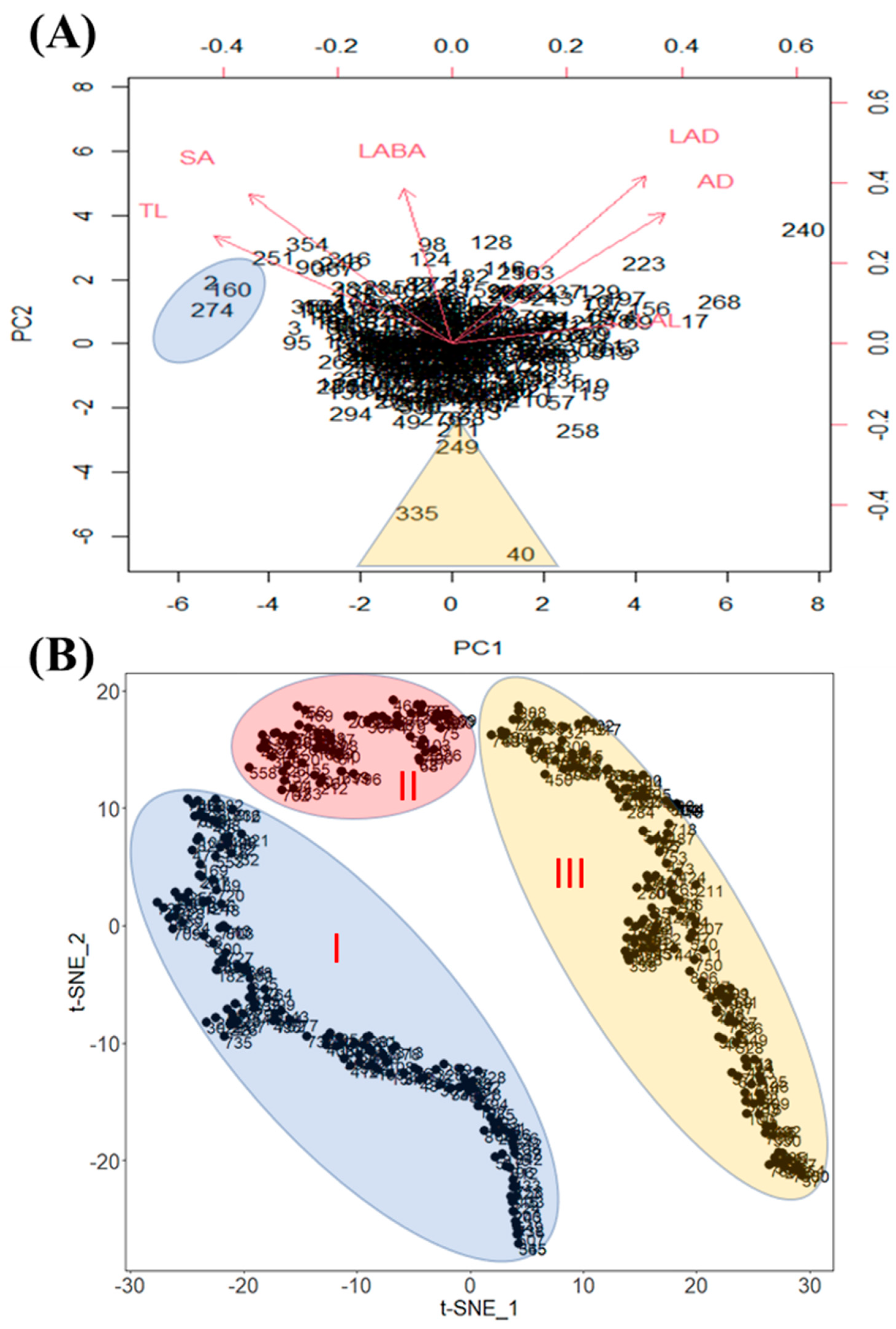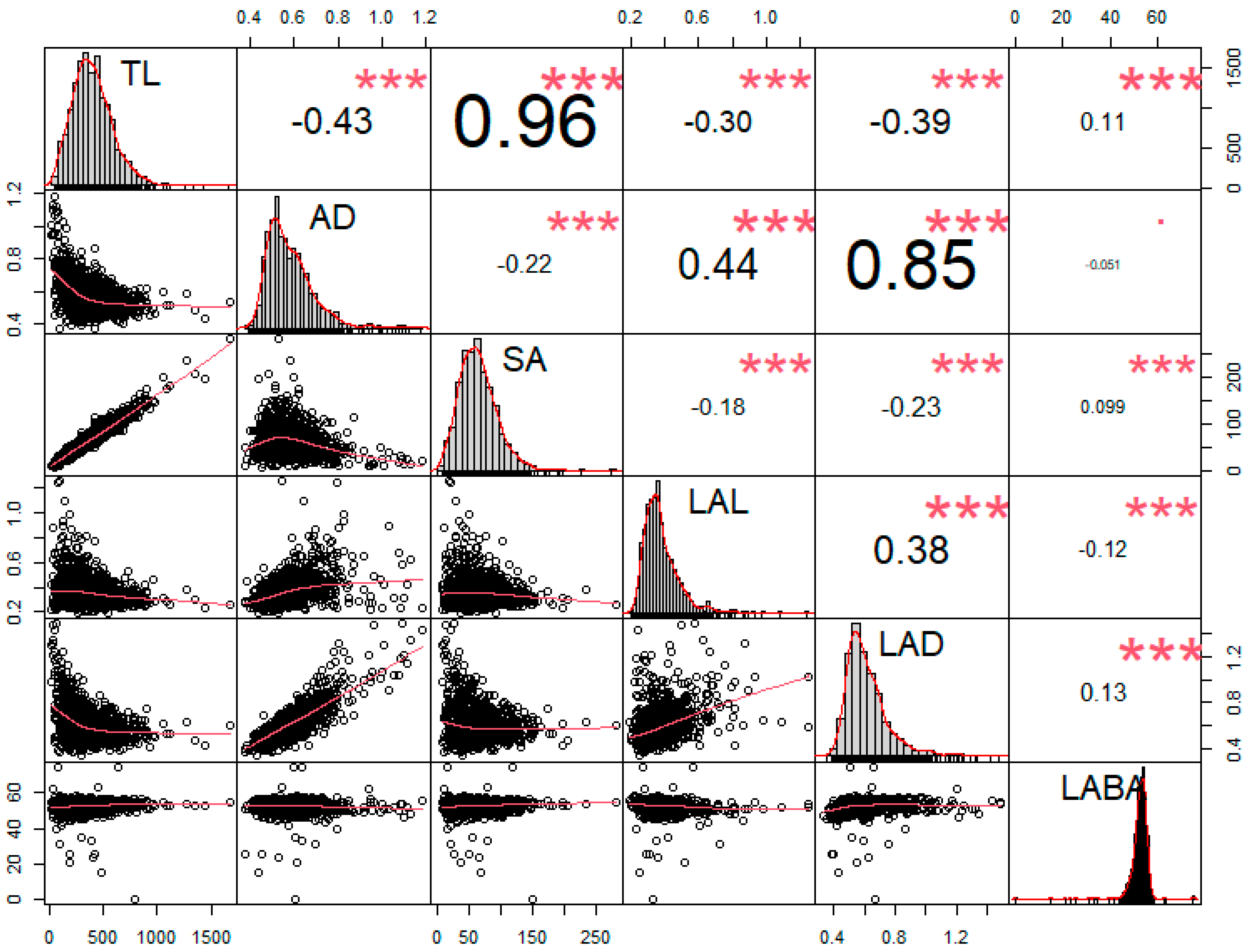Investigation of Root Morphological Traits Using 2D-Imaging among Diverse Soybeans (Glycine max L.)
Abstract
:1. Introduction
2. Materials and Methods
2.1. Plant Materials, Growth Conditions
2.2. Determination of Root Phenotypes
2.3. PCA Plot Analysis
2.4. Statistical Analysis
3. Results
3.1. Seed Collection Area
3.2. Variability of Root Morphological Traits
3.3. Correlation
4. Discussion
5. Conclusions
Supplementary Materials
Author Contributions
Funding
Institutional Review Board Statement
Informed Consent Statement
Data Availability Statement
Conflicts of Interest
References
- Foyer, C.H.; Lam, H.-M.; Nguyen, H.T.; Siddique, K.H.; Varshney, R.K.; Colmer, T.D.; Cowling, W.; Bramley, H.; Mori, T.A.; Hodgson, J.M. Neglecting legumes has compromised human health and sustainable food production. Nat. Plants 2016, 2, 16112. [Google Scholar] [CrossRef]
- Mourtzinis, S.; Specht, J.E.; Lindsey, L.E.; Wiebold, W.J.; Ross, J.; Nafziger, E.D.; Kandel, H.J.; Mueller, N.; Devillez, P.L.; Arriaga, F.J. Climate-induced reduction in US-wide soybean yields underpinned by region-and in-season-specific responses. Nat. Plants 2015, 1, 14026. [Google Scholar] [CrossRef]
- Kim, Y.; Chung, Y.S.; Lee, E.; Tripathi, P.; Heo, S.; Kim, K.-H. Root response to drought stress in rice (Oryza sativa L.). Int. J. Mol. Sci. 2020, 21, 1513. [Google Scholar] [CrossRef] [PubMed] [Green Version]
- Sadeghipour, O.; Abbasi, S. Soybean response to drought and seed inoculation. World Appl. Sci. J. 2012, 17, 55–60. [Google Scholar]
- Farooq, M.; Gogoi, N.; Barthakur, S.; Baroowa, B.; Bharadwaj, N.; Alghamdi, S.S.; Siddique, K. Drought stress in grain legumes during reproduction and grain filling. J. Agron. Crop Sci. 2017, 203, 81–102. [Google Scholar] [CrossRef]
- Karrou, M.; Oweis, T. Water and land productivities of wheat and food legumes with deficit supplemental irrigation in a Mediterranean environment. Agric. Water Manag. 2012, 107, 94–103. [Google Scholar] [CrossRef]
- Manschadi, A.M.; Christopher, J.; deVoil, P.; Hammer, G.L. The role of root architectural traits in adaptation of wheat to water-limited environments. Funct. Plant Biol. 2006, 33, 823–837. [Google Scholar] [CrossRef] [Green Version]
- Kunert, K.J.; Vorster, B.J.; Fenta, B.A.; Kibido, T.; Dionisio, G.; Foyer, C.H. Drought stress responses in soybean roots and nodules. Front. Plant Sci. 2016, 7, 1015. [Google Scholar] [CrossRef] [Green Version]
- Hodge, A.; Berta, G.; Doussan, C.; Merchan, F.; Crespi, M. Plant root growth, architecture and function. Plant Soil 2009, 321, 153–187. [Google Scholar] [CrossRef]
- Chung, Y.S.; Kim, S.H.; Park, C.W.; Na, C.I.; Kim, Y. Treatment with silicon fertilizer induces changes in root morphological traits in soybean (Glycine max L.) during early growth. J. Crop. Sci. Biotechnol. 2020, 23, 445–451. [Google Scholar] [CrossRef]
- Zegada-Lizarazu, W.; Iijima, M. Deep root water uptake ability and water use efficiency of pearl millet in comparison to other millet species. Plant Prod. Sci. 2005, 8, 454–460. [Google Scholar] [CrossRef]
- Koevoets, I.T.; Venema, J.H.; Elzenga, J.T.; Testerink, C. Roots withstanding their environment: Exploiting root system architecture responses to abiotic stress to improve crop tolerance. Front. Plant Sci. 2016, 7, 1335. [Google Scholar] [CrossRef] [Green Version]
- Kulkarni, M.; Soolanayakanahally, R.; Ogawa, S.; Uga, Y.; Selvaraj, M.G.; Kagale, S. Drought response in wheat: Key genes and regulatory mechanisms controlling root system architecture and transpiration efficiency. Front. Chem. 2017, 5, 106. [Google Scholar] [CrossRef] [PubMed] [Green Version]
- Uga, Y.; Sugimoto, K.; Ogawa, S.; Rane, J.; Ishitani, M.; Hara, N.; Kitomi, Y.; Inukai, Y.; Ono, K.; Kanno, N. Control of root system architecture by DEEPER ROOTING 1 increases rice yield under drought conditions. Nat. Genet. 2013, 45, 1097–1102. [Google Scholar] [CrossRef] [PubMed]
- Cai, Q.; Zhang, Y.; Sun, Z.; Zheng, J.; Bai, W.; Zhang, Y.; Liu, Y.; Feng, L.; Chen, F.; Zhang, Z. Morphological plasticity of root growth under mild water stress increases water use efficiency without reducing yield in maize. Biogeosciences 2017, 14, 3851. [Google Scholar] [CrossRef] [Green Version]
- Ayalew, H.; Liu, H.; Börner, A.; Kobiljski, B.; Liu, C.; Yan, G. Genome-wide association mapping of major root length QTLs under PEG induced water stress in wheat. Front. Plant Sci. 2018, 9, 1759. [Google Scholar] [CrossRef]
- Suralta, R.R.; Kano-Nakata, M.; Niones, J.M.; Inukai, Y.; Kameoka, E.; Tran, T.T.; Menge, D.; Mitsuya, S.; Yamauchi, A. Root plasticity for maintenance of productivity under abiotic stressed soil environments in rice: Progress and prospects. Field Crops Res. 2018, 220, 57–66. [Google Scholar] [CrossRef]
- Fried, H.G.; Narayanan, S.; Fallen, B. Characterization of a soybean (Glycine max L. Merr.) germplasm collection for root traits. PLoS ONE 2018, 13, e0200463. [Google Scholar] [CrossRef] [PubMed] [Green Version]
- Poorter, H.; Nagel, O.J.F.P.B. The role of biomass allocation in the growth response of plants to different levels of light, CO2, nutrients and water: A quantitative review. Funct. Plant Biol. 2000, 27, 1191. [Google Scholar] [CrossRef] [Green Version]
- Fitter, A.H. Characteristics and functions of root systems. In Plant Roots, 3rd ed.; Waisel, Y., Eshel, A., Beeckman, T., Kafkafi, U., Eds.; CRC Press: Boca Raton, FL, USA, 2002; pp. 1–29. [Google Scholar]
- Manschadi, A.M.; Hammer, G.L.; Christopher, J.T.; deVoil, P. Genotypic variation in seedling root architectural traits and implications for drought adaptation in wheat (Triticum aestivum L.). Plant Soil 2008, 303, 115–129. [Google Scholar] [CrossRef]
- Tripathi, P.; Na, C.-I.; Kim, Y. Effect of silicon fertilizer treatment on nodule formation and yield in soybean (Glycine max L.). Eur. J. Agron. 2021, 122, 126172. [Google Scholar] [CrossRef]
- Lobet, G.; Pagès, L.; Draye, X. A novel image-analysis toolbox enabling quantitative analysis of root system architecture. Plant Physiol. 2011, 157, 29–39. [Google Scholar] [CrossRef] [PubMed] [Green Version]
- Jeudy, C.; Adrian, M.; Baussard, C.; Bernard, C.; Bernaud, E.; Bourion, V.; Busset, H.; Cabrera-Bosquet, L.; Cointault, F.; Han, S. RhizoTubes as a new tool for high throughput imaging of plant root development and architecture: Test, comparison with pot grown plants and validation. Plant Methods 2016, 12, 31. [Google Scholar] [CrossRef]
- Jin, J.A.; Wang, G.H.; Liu, X.B.; Mi, L.A.; Li, Y.H.; Xu, Y.X.; Herbert, S.J. Genetic improvement of yield shapes the temporal and spatial root morphology of soybean (Glycine max) grown in north-east China. N. Z. J. Crop Hor. 2010, 38, 177–188. [Google Scholar] [CrossRef] [Green Version]
- Bayuelo-Jiménez, J.S.; Gallardo-Valdéz, M.; Pérez-Decelis, V.A.; Magdaleno-Armas, L.; Ochoa, I.; Lynch, J.P. Genotypic variation for root traits of maize (Zea mays L.) from the Purhepecha Plateau under contrasting phosphorus availability. Field Crops Res. 2011, 121, 350–362. [Google Scholar] [CrossRef]
- Gaur, P.M.; Krishnamurthy, L.; Kashiwagi, J. Improving drought-avoidance root traits in chickpea (Cicer arietinum L.)—Current status of research at ICRISAT. Plant Prod. Sci. 2008, 11, 3–11. [Google Scholar] [CrossRef] [Green Version]
- Gahoonia, T.S.; Ali, O.; Sarker, A.; Nielsen, N.E.; Rahman, M.M. Genetic variation in root traits and nutrient acquisition of lentil genotypes. J. Plant Nutritr. 2006, 29, 643–655. [Google Scholar] [CrossRef]
- Narayanan, S.; Mohan, A.; Gill, K.S.; Prasad, P.V. Variability of root traits in spring wheat germplasm. PLoS ONE 2014, 9, e100317. [Google Scholar] [CrossRef]
- Sallam, A.; Martsch, R.; Moursi, Y.S. Genetic variation in morpho-physiological traits associated with frost tolerance in faba bean (Vicia faba L.). Euphytica 2015, 205, 395–408. [Google Scholar] [CrossRef]
- Asfaw, A.; Blair, M.W. Quantitative trait loci for rooting pattern traits of common beans grown under drought stress versus non-stress conditions. Mol. Breed. 2012, 30, 681–695. [Google Scholar] [CrossRef]
- Tuberosa, R.; Salvi, S.; Sanguineti, M.C.; Maccaferri, M.; Giuliani, S.; Landi, P. Searching for quantitative trait loci controlling root traits in maize: A critical appraisal. Plant Soil 2003, 255, 35–54. [Google Scholar] [CrossRef]
- Collard, B.C.; Jahufer, M.; Brouwer, J.; Pang, E. An introduction to markers, quantitative trait loci (QTL) mapping and marker-assisted selection for crop improvement: The basic concepts. Euphytica 2005, 142, 169–196. [Google Scholar] [CrossRef]
- Fenta, B.A.; Beebe, S.E.; Kunert, K.J.; Burridge, J.D.; Barlow, K.M.; Lynch, J.P.; Foyer, C.H. Field phenotyping of soybean roots for drought stress tolerance. Agronomy 2014, 4, 418–435. [Google Scholar] [CrossRef] [Green Version]
- Kim, D.-W.; Yun, H.S.; Jeong, S.-J.; Kwon, Y.-S.; Kim, S.-G.; Lee, W.S.; Kim, H.-J. Modeling and testing of growth status for Chinese cabbage and white radish with UAV-based RGB imagery. Remote Sens. 2018, 10, 563. [Google Scholar] [CrossRef] [Green Version]
- Lei, L.; Qiu, C.; Li, Z.; Han, D.; Han, L.; Zhu, Y.; Wu, J.; Xu, B.; Feng, H.; Yang, H. Effect of leaf occlusion on leaf area index inversion of maize using UAV–LiDAR data. Remote Sens. 2019, 11, 1067. [Google Scholar] [CrossRef] [Green Version]
- Yasrab, R.; Zhang, J.; Smyth, P.; Pound, M.P. Predicting Plant Growth from Time-Series Data Using Deep Learning. Remote Sens. 2021, 13, 331. [Google Scholar] [CrossRef]
- Pornaro, C.; Macolino, S.; Menegon, A.; Richardson, M. WinRHIZO technology for measuring morphological traits of bermudagrass stolons. Agron. J. 2017, 109, 3007–3010. [Google Scholar] [CrossRef] [Green Version]
- Wang, M.-B.; Zhang, Q. Issues in using the WinRHIZO system to determine physical characteristics of plant fine roots. Acta Ecol. Sin. 2009, 29, 136–138. [Google Scholar] [CrossRef]
- Brennan, A.; Jiménez, E.M.; Puschenreiter, M.; Alburquerque, J.A.; Switzer, C. Effects of biochar amendment on root traits and contaminant availability of maize plants in a copper and arsenic impacted soil. Plant Soil 2014, 379, 351–360. [Google Scholar] [CrossRef] [Green Version]
- Garner, W.W.; Allard, H.A. Photoperiodic Response of Soybeans in Relation to Temperature and Other Environmental Factors; United States Department of Agriculture: Washington, DC, USA, 1930. [Google Scholar]
- Song, W.; Sun, S.; Ibrahim, S.E.; Xu, Z.; Wu, H.; Hu, X.; Jia, H.; Cheng, Y.; Yang, Z.; Jiang, S. Standard cultivar selection and digital quantification for precise classification of maturity groups in soybean. Crop Sci. 2019, 59, 1997–2006. [Google Scholar] [CrossRef] [Green Version]





| Trait | Source | DF | Sum of Squares | Mean Square | F Value | Pr > F |
|---|---|---|---|---|---|---|
| TL | variety | 371 | 16,319,131 | 43,986.88 | 1.29 | 0.0022 |
| rep | 2 | 50,091.84 | 25,045.92 | 0.73 | 0.481 | |
| AD | variety | 371 | 4.9579692 | 0.0133638 | 1.73 | <0.0001 |
| rep | 2 | 2.7102099 | 1.3551049 | 175.8 | <0.0001 | |
| SA | variety | 371 | 418,755.69 | 1128.7215 | 1.33 | 0.0007 |
| rep | 2 | 27,824.935 | 13912.468 | 16.34 | <0.0001 | |
| LAL | variety | 371 | 4.9751331 | 0.0134101 | 1.23 | 0.0107 |
| rep | 2 | 1.3963546 | 0.6981773 | 63.85 | <0.0001 | |
| LAD | variety | 371 | 8.7093611 | 0.0234754 | 1.31 | 0.0012 |
| rep | 2 | 2.7739838 | 1.3869919 | 77.36 | <0.0001 | |
| LABA | variety | 371 | 7059.1998 | 19.027493 | 1.5 | <0.0001 |
| rep | 2 | 36.150078 | 18.075039 | 1.43 | 0.2401 |
| Genotype | Traits | ||||||
|---|---|---|---|---|---|---|---|
| TL | SA | AD | LAL | LAD | LABA | ||
| Highest 5% | IT 165308 | * | * | * | |||
| IT 199127 | * | * | * | ||||
| IT 165432 | * | * | * | ||||
| IT 165282 | * | * | * | ||||
| Lowest 5% | IT 23305 | * | * | * | * | ||
| IT 208266 | * | * | * | * | |||
| IT 165208 | * | * | * | ||||
| IT 156289 | * | * | * | ||||
| IT 165405 | * | * | * | ||||
| IT 165019 | * | * | * | ||||
| IT 165839 | * | * | * | ||||
| IT 203565 | * | * | * | ||||
| IT 181034 | * | * | * | ||||
| Correlated Variables | p-Value | Rank | (i/m)/Q |
|---|---|---|---|
| TL×SA | 0.000000 | 1 | 0.0033333 |
| TL×AD | 0.0000000 | 2 | 0.0066667 |
| TL×LAL | 0.0000000 | 3 | 0.0100000 |
| TL×LAD | 0.0000000 | 4 | 0.0133333 |
| SA×AD | 0.0000000 | 5 | 0.0166667 |
| SA×LAL | 0.0000000 | 6 | 0.0200000 |
| LAL×LAD | 0.0000000 | 7 | 0.0233333 |
| AD×LAL | 0.0000000 | 8 | 0.0266667 |
| AD×LAD | 0.0000000 | 9 | 0.0300000 |
| TL×LABA | 0.0002000 | 10 | 0.0333333 |
| SA×LAD | 0.0002000 | 11 | 0.0366667 |
| SA×LABA | 0.0002000 | 12 | 0.0400000 |
| LAD×LABA | 0.0016000 | 13 | 0.0433333 |
| LAL×LABA | 0.0198000 | 14 | 0.0466667 |
| AD×LABA | 0.2604000 | 15 | 0.0500000 |
Publisher’s Note: MDPI stays neutral with regard to jurisdictional claims in published maps and institutional affiliations. |
© 2021 by the authors. Licensee MDPI, Basel, Switzerland. This article is an open access article distributed under the terms and conditions of the Creative Commons Attribution (CC BY) license (https://creativecommons.org/licenses/by/4.0/).
Share and Cite
Tripathi, P.; Abdullah, J.S.; Kim, J.; Chung, Y.-S.; Kim, S.-H.; Hamayun, M.; Kim, Y. Investigation of Root Morphological Traits Using 2D-Imaging among Diverse Soybeans (Glycine max L.). Plants 2021, 10, 2535. https://doi.org/10.3390/plants10112535
Tripathi P, Abdullah JS, Kim J, Chung Y-S, Kim S-H, Hamayun M, Kim Y. Investigation of Root Morphological Traits Using 2D-Imaging among Diverse Soybeans (Glycine max L.). Plants. 2021; 10(11):2535. https://doi.org/10.3390/plants10112535
Chicago/Turabian StyleTripathi, Pooja, Jamila S. Abdullah, Jaeyoung Kim, Yong-Suk Chung, Seong-Hoon Kim, Muhammad Hamayun, and Yoonha Kim. 2021. "Investigation of Root Morphological Traits Using 2D-Imaging among Diverse Soybeans (Glycine max L.)" Plants 10, no. 11: 2535. https://doi.org/10.3390/plants10112535
APA StyleTripathi, P., Abdullah, J. S., Kim, J., Chung, Y.-S., Kim, S.-H., Hamayun, M., & Kim, Y. (2021). Investigation of Root Morphological Traits Using 2D-Imaging among Diverse Soybeans (Glycine max L.). Plants, 10(11), 2535. https://doi.org/10.3390/plants10112535







